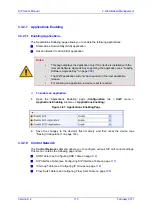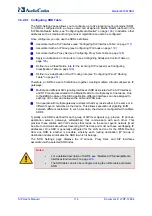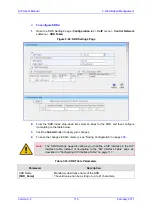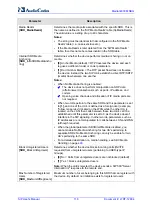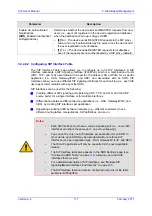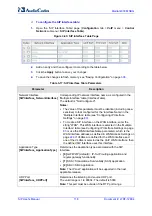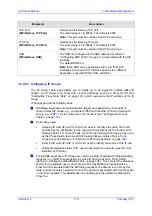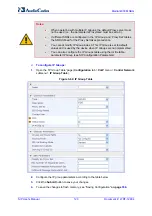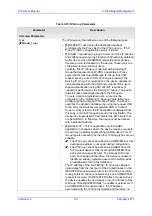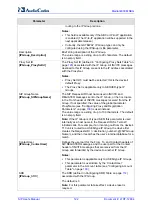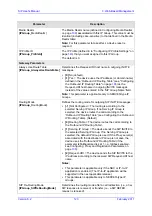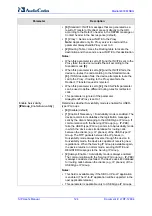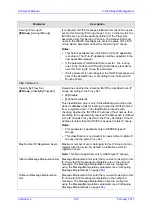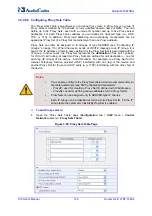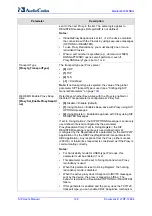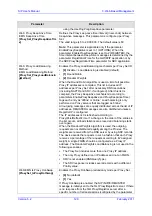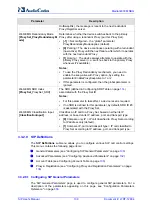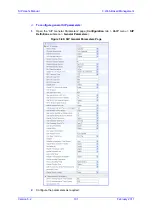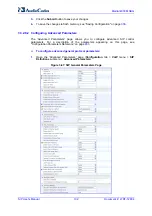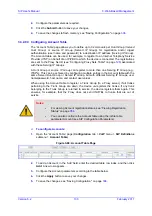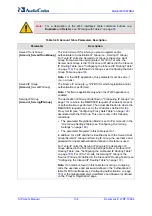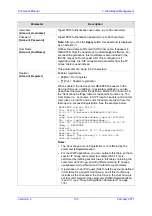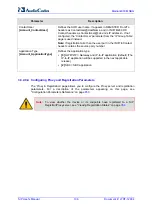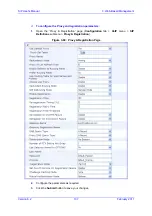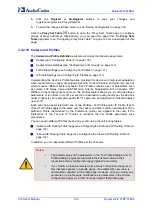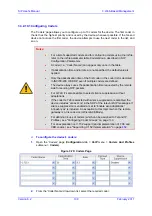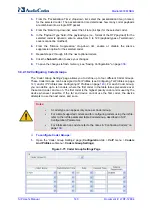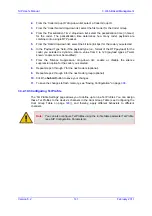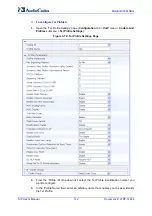
Version 6.2
127
February 2011
SIP User's Manual
3. Web-Based Management
2.
From the 'Proxy Set ID' drop-down list, select an ID for the desired group.
3.
Configure the Proxy parameters according to the following table.
4.
Click the
Submit
button to save your changes.
5.
To save the changes to flash memory, see ''Saving Configuration'' on page
Table
3-19: Proxy Sets Table Parameters
Parameter
Description
Web: Proxy Set ID
EMS: Index
[ProxySet_Index]
The Proxy Set identification number.
The valid range is 0 to 31. The Proxy Set ID 0 is used as the
default Proxy Set.
Note:
Although not recommended, you can use both default
Proxy Set (ID 0) and IP Groups for call routing. For example, on
the 'Hunt Group Settings' page (see ''Configuring Hunt Group
Settings'' on page
) you can configure a Serving IP Group to
where you want to route specific Hunt Group's channels, while all
other device channels use the default Proxy Set. At the same,
you can also use IP Groups in the 'Outbound IP Routing Table'
(see ''Configuring the Outbound IP Routing Table'' on page
)
to configure the default Proxy Set if the parameter
PreferRouteTable is set to 1.
To summarize, if the default Proxy Set is used, the INVITE
message is sent according to the following preferences:
To the Hunt Group's Serving IP Group ID, as defined in the
'Hunt Group Settings' table.
According to the 'Outbound IP Routing Table' if the parameter
PreferRouteTable is set to 1.
To the default Proxy.
Typically, when IP Groups are used, there is no need to use the
default Proxy, and all routing and registration rules can be
configured using IP Groups and the Account tables (see
''Configuring Account Table'' on page
).
Proxy Address
[ProxyIp_IpAddress]
The IP address (and optionally port number) of the Proxy server.
Up to five IP addresses can be configured per Proxy Set. Enter
the IP address as an FQDN or in dotted-decimal notation (e.g.,
201.10.8.1). You can also specify the selected port in the format:
<IP address>:<port>.
If you enable Proxy Redundancy (by setting the parameter
EnableProxyKeepAlive to 1 or 2), the device can operate with
multiple Proxy servers. If there is no response from the first
(
primary
) Proxy defined in the list, the device attempts to
communicate with the other (
redundant
) Proxies in the list. When
a redundant Proxy is located, the device either continues
operating with it until the next failure occurs or reverts to the
primary Proxy (refer to the parameter ProxyRedundancyMode). If
none of the Proxy servers respond, the device goes over the list
again.
The device also provides real-time switching (Hot-Swap mode)
between the primary and redundant proxies (refer to the
parameter IsProxyHotSwap). If the first Proxy doesn't respond to
the INVITE message, the same INVITE message is immediately
Summary of Contents for Mediant 800 MSBG
Page 2: ......
Page 366: ...SIP User s Manual 366 Document LTRT 12804 Mediant 800 MSBG Reader s Notes ...
Page 372: ...SIP User s Manual 372 Document LTRT 12804 Mediant 800 MSBG Reader s Notes ...
Page 390: ...SIP User s Manual 390 Document LTRT 12804 Mediant 800 MSBG Reader s Notes ...
Page 404: ...SIP User s Manual 404 Document LTRT 12804 Mediant 800 MSBG Reader s Notes ...
Page 616: ...SIP User s Manual 616 Document LTRT 12804 Mediant 800 MSBG Reader s Notes ...
Page 636: ...SIP User s Manual 636 Document LTRT 12804 Mediant 800 MSBG Reader s Notes ...
Page 652: ...SIP User s Manual 652 Document LTRT 12804 Mediant 800 MSBG Reader s Notes ...
Page 886: ...SIP User s Manual 886 Document LTRT 12804 Mediant 800 MSBG Reader s Notes ...

